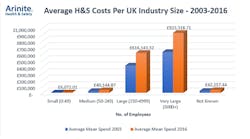UK Study: Average Health and Safety Fines £75,000 Higher Than the Cost of Compliance
UK businesses paid an average of £115,440 in fines for being found guilty of a health and safety breach in 2016. That’s according to the latest prosecution data from the Health and Safety Executive (HSE).
In contrast, the cost of health and safety compliance for companies in 2016 ranged between £5,000 and £40,000. SMEs that invested in health and safety therefore potentially avoided a fine £75,000 higher than the cost of compliance. This is according to research done by Arinite health and safety consultants.
A total of £32,438,677 worth of fines were issued in 2016 across the UK. Half of the total fines issued came from the manufacturing industry (£16,816,673), followed by extractive and utility supply companies (£7,375,120) followed by construction (£4,824,983).
Most suspended prison sentences came from manufacturing and construction.
EHS Compliance Costs Worth the Investment
The largest fines in Britain have been growing steadily over the past few years. Despite warnings, it appears many businesses fail to comply by the HSE’s stringent compliance rules. The largest 20 fines to businesses for health and safety violations in 2016 were three times more than the largest 20 fines in 2015, and eight times higher than in 2014.
Why are more companies failing to comply and why are the fines getting steeper? Almost all major organizations are likely to have a written health and safety policy, an accident reporting system and have a designated health and safety role or person. The majority of accidents therefore usually are avoidable. While investment in safety is a factor, simple communication between employees and fostering a culture of safety are the most effective ways to save lives in the workplace.
For small- to medium-sized businesses (i.e. businesses of up to 249 employees), the cost of compliance is on average not much over £40,000 per year. However, for larger businesses, the compliance costs can be a lot higher. Companies with between 250-4,999 employees might expect annual compliance costs to reach over £600,000.
But bear in mind, health and safety failures at these companies never just result in a fine; a major accident incurs the total cost of injuries and ill health sustained (not to mention the PR costs if these violations make national headlines). The HSE estimate that the total cost of injuries and ill health from working conditions in 2014-15 was £14.1 billion, out of which £2.8 billion were covered by the employer.
Penalty Costs and Volume of Fines Rising
The largest HSE fine in 2016 cost £5 million and was issued to Alton Towers operator Merlin Attractions for the notorious Smiler roller coaster accident. The second largest fine in 2016 went to Cristal Pigment UK Ltd., a chemical company with 4,000 employees, which was fined £3 million when a worker was killed and one left with life-changing injuries when they were exposed to a toxic vapour cloud.
These are serious fines and demonstrate the heights a penalty can soar. And that’s not even the highest a fine potentially could be: As of Feb. 1, 2016, new sentencing guidelines were introduced. Larger companies could face over £10 million in costs for the most serious health and safety violations, and more than £20 million for corporate manslaughter convictions.
“Health and safety offenses can ruin lives, devastate families and inhibit precious talent,” said Shelley Frost, executive director of policy at the Institution of Occupational Safety and Health (IOSH), about the raised sentences. “Whilst you cannot put a value on human life, the level of fines now being handed out recognizes society’s disapproval of serious corporate failures that lead to injury, illness and death. It reflects a desire to deter others from making the same errors and takes significant steps forward in aligning penalties for these offenses with other regulatory breaches in the UK.”
How Businesses Can Mitigate Risk
Often it can be tough to judge just exactly how compliant one is as a company. Helpfully, IOSH have provided specifics on how businesses can prevent and reduce the cost of a fine. The main factors increasing seriousness include:
- Cost-cutting at the expense of safety.
- Deliberate concealment of illegal activity.
- Breaching a court order.
- Obstruction of justice.
- A poor health and safety record – it’s worse if there was a previous conviction.
They also outline a series of factors that could help reduce the seriousness of the violation. They are:
- Effective health and safety procedures in place.
- Evidence of steps taken voluntarily to remedy a problem.
- High level of cooperation with the investigation.
- A good health and safety record – and having no previous convictions.
In 2017, it might be worth reviewing safety practices and ensuring compliance above and beyond the standard set in previous years. While compliance costs may not be rising steeply, the penalty costs certainly are.
About the author: Bryan Richards is the director of Arinite, a health and safety consultancy based in London. He has over 25 years’ experience as both a health and safety practitioner and environmental health officer.
